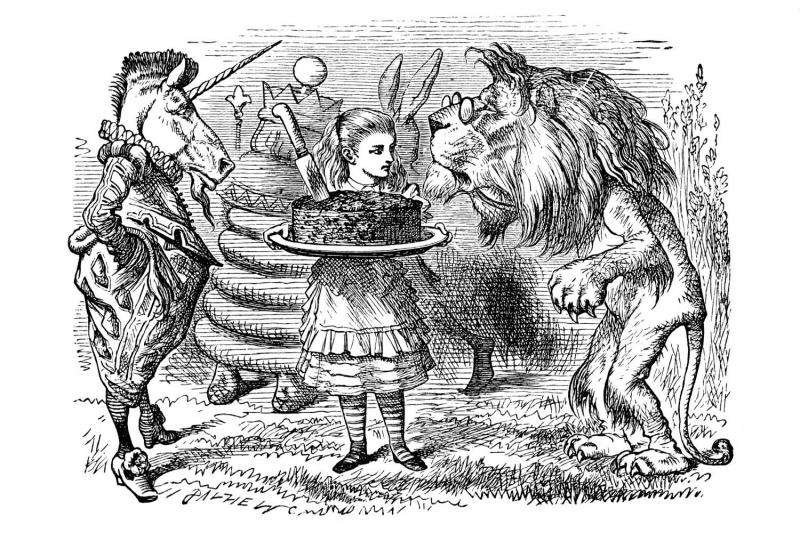A study led by a UConn researcher suggests that the way food is portrayed in picture books may be sending the wrong messages to children about healthy eating. Credit: Illustration from Alice Through the Looking Glass by Sir John Tenniel.
Reading picture books aloud remains a cherished ritual of childhood – one enjoyed by adults and children alike, whether at bedtime, in pre-school, or during story hour at the public library.
Little wonder. The brightly illustrated stories evoke happiness, discovery, and loving family relationships. Many of them also feature food, especially ice cream and desserts. After all, nothing says mama loves you like a plate of homemade chocolate chip cookies.
But could the way food is portrayed in picture books be sending the wrong messages to children about healthy eating? A study led by a UConn researcher suggests that it does.
The study – conducted by Jane Goldman, professor emerita in the Department of Human Development and Family Studies, and Lara Descartes, a former assistant professor with the department and now a professor of Family Studies at Brescia University College in Canada – found that while the ratio of healthy to unhealthy foods depicted in books is higher than it is on television, books more often link positive events and concepts – such as love and nurturing – to treats, such as ice cream and baked goods, rather than fruits or vegetables.
"It's not that you shouldn't have ice cream in books, but people should be aware of what the underlying message is," says Goldman. "What are the messages children are getting about foods when a picture book is read to them, and are those messages related to the obesity epidemic among children?"
The findings were first published in 2016 in the journal Appetite and were the focus of presentations by Goldman and Descartes in September at the University of California at Irvine and a global conference on food in the United Kingdom. They evaluated 100 picture book titles in Scholastic's "Favorite Books for Preschoolers" collection – a mix of classics and newer titles, fiction and non-fiction. Sixty-nine of the 100 books in the collection included one or more food items in the text and/or illustrations. These books formed the sample in the study.
Goldman and Descartes coded depictions of food in the books using a number of criteria. First they counted the number of books in which each food was represented. Using more specific criteria, they narrowed the sample to 48 books and conducted a page-by-page assessment of the context in which each food was presented. They coded the references based on the centrality of the food, in other words, how likely the representation of the food was to attract attention. Then, using characters' expressions as a guide, they assigned a rating of positive, negative or neutral to each food reference.
Based on frequency alone, the depictions of healthy versus nutrient-poor foods was encouraging:
- Almost all 69 picture books in the sample depict one or more healthy foods;
- Twenty-nine (42 percent) depict only healthy foods;
- Thirty-three (48 percent) depict both healthy and nutrient-poor food, but the majority of the depictions are healthy foods.
But a different picture emerges when "centrality" and "affect" ratings are considered.
- Fruits, while depicted in more than half the books, are most often in the background;
- Only one-third of fruit depictions received a positive "affect" rating;
- Vegetable are depicted in more than a third of the books and centrally portrayed in more than half, but only 18 percent of the depictions received a positive "affect" rating;
- Sweetened baked goods are both centrally positioned, and have a positive "affect" about 80 percent of the time.
- Five of the seven times ice cream is mentioned, it's offered as a treat, to make someone feel better, or as a happy ending.
Goldman was not surprised that many of the picture books surveyed in the study portrayed sweet and comparatively unhealthy foods as very desirable or that they were associated with positive outcomes. This is concerning, she says, because when nutrient- poor foods are presented both frequently and positively, it likely contributes to children's view of them as more desirable. This is especially likely given the fact that picture books are just one part of a child's total media consumption and that television content is known to promote a positive association with nutrient-poor foods.
The researchers say it's important to look at the context in which foods are presented as well as the frequency, observing that the people they interviewed rarely noticed that food was mentioned in children's books, nor what messages were being conveyed.
By being aware of the issue, parents, educators, and others have the option of emphasizing healthier food choices such as apples or carrots, in addition to the sweets, baked goods, and ice cream they are seeing, Goldman says. Secondarily, she hopes the study makes editors and writers aware of the stereotypes they may be perpetuating about sweets always being the food with which people are rewarded and made to feel good.
"What we hope the study does is make people aware of how food is presented in picture books, in the same way they have become aware of how gender roles are presented in books," Goldman says. "Books are a tool we use all the time, so how can we use books to promote healthy ideas about food. In early childhood there is an emphasis on helping children read and on healthy eating and lifestyle, so why not think about the messages in books that support or contradict that healthy lifestyle message."
More information: Jane A. Goldman et al. Food depictions in picture books for preschool children: Frequency, centrality, and affect, Appetite (2016). DOI: 10.1016/j.appet.2015.09.018
Journal information: Appetite
Provided by University of Connecticut






















